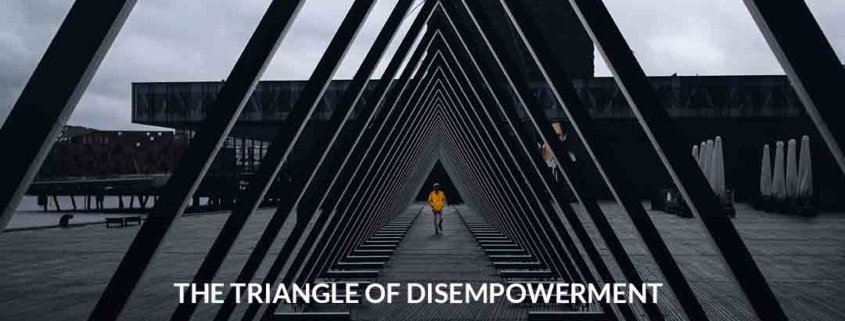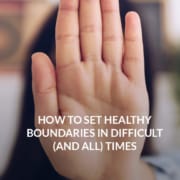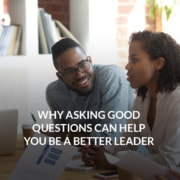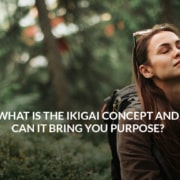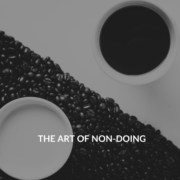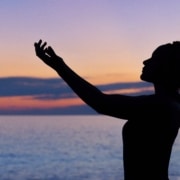The Triangle of Disempowerment
Tell me… do you know what disempowerment means?
It means to cause someone to be less powerful, making them less likely to succeed.
If we look around the world, there are endless examples of disempowerment and many of us, when we see these situations, are able to say, “That isn’t right. That needs to stop.”
But… are you able to recognize when you are the one being disempowered? What about when the person causing you to be less powerful is also… you?
We have a word for this – self-sabotage – but it sounds aggressive and we tend to think, “I would never sabotage myself and I’d notice if I were doing it.”
But when we look at that less aggressive definition – causing ourselves to be less powerful and less likely to succeed – and reflect on the ways we speak to ourselves and how that translates to our choices and behaviours, it becomes clearer how we can slide into stories of disempowerment without realizing it.
The Struggle is Real, the Lens is Not
The word “disempower” puts the power where it truly is: within you. If you can disempower yourself, you can empower yourself.
So… why is it such a struggle? Why is it so hard to empower our best selves forward?

It comes down to patterns. Patterns we grew up with, patterns that surround us, patterns we fell into during difficult times… patterns not only become comfort zones, they become our lens.
When we experience a pattern over and over again, it can become the lens through which we see the world. “This is just the way it is”, we believe. That’s what keeps us stuck – the belief that this is the world and there’s nothing we can do about it.
The truth is, you create your world. Whether you empower yourself to make things happen for you, or you disempower yourself with a mindset that things just happen to you, you are creating your world.
The Triangle of Disempowerment
The concept of the triangle was first described in the 1960’s by the psychiatrist Dr. Stephen B. Karpman, who referred to it as the “Drama Triangle”. The Drama Triangle framework has been used to understand a number of different relationship dynamics. In my leadership training, the term “Triangle of Disempowerment” was used and it’s the term I prefer because it tells you, right away, why you don’t want to let yourself get caught in this type of dynamic. After all, it may sound harmless to enjoy a little drama from time to time, but when you realize the ways it can take your power away, you’re better positioned to take back authorship of your life.
Although you may not have heard the phrase, the “triangle of disempowerment” (or drama triangle – whichever term you prefer) is an incredibly common pattern that you’re probably familiar with. If you’re not currently stuck in this triangle, odds are you’ve been caught up in it before. I know I have!
The triangle if disempowerment is a lot like a story with 3 main characters:
• The Victim
The Victim has a mindset of “I’m not good enough and I never will be. The cards are stacked against me and there’s nothing I can do about it. I’m just not made that way and I can’t do what others can do.”
With all these uncontrollable forces, the Victim is absolved of any responsibility for their world, and believes it’s the responsibility of others to help them because they are unable to help themselves. They may also use blame claiming their eternal victimhood is the fault of how they were raised, or some other force they did not choose.
• The Rescuer
The Rescuer derives purpose and self worth from what they can do for others, and doesn’t see themselves as having value outside that. Often, the Rescuer mindset is a way to avoid responsibility for their own personal growth by claiming responsibility for the growth or success of others.
The Rescuer needs to be needed and sometimes even takes on the role of martyr, claiming they need to sacrifice themselves for the good of those around them.
• The Persecutor
The Persecutor believes the world is dangerous and everyone is out to get them, so they need to stay on the defensive. Persecutors are often aggressive and combative, believing they need to strike first so no one can take advantage of them. Not surprisingly, by showing up from a place of war, the Persecutor puts others on the defensive, thereby creating a world for themselves that matches their belief.
The Persecutor’s greatest fear is losing control and becoming a Victim.
These 3 characters need each other. The Victim needs the Rescuer to enable them and the Persecutor to provide “proof” that the world really is stacked against them. The Rescuer needs the Victim to give them purpose and the Persecutor to provide a villain from whom to protect the Victim. The Persecutor also needs the Victim to provide “proof” – proof that the world is dangerous and their greatest fear is real. They also need the Rescuer as proof that no one will help them, so they have no choice but to look out for number one.
Think about classic fairy tales. There is almost always a damsel in distress who is victimized by the villain and must be rescued by the prince. It’s a story we’re so familiar with that we play it out in life over and over again (although in life, the characters can be of any gender identity).
Getting Stuck in the Triangle
Think about the Bermuda Triangle – expert navigators getting caught in the chaos, unable to find their way out.

Being “stuck” means to be caught in repetitive patterns or stories that play out over and over again. The stuck person struggles to see a way out and often isn’t even aware of how they are creating their stuck situation, much like a lost pilot, completely unaware that they’ve been going in circles.
There are many ways we can get stuck in life – different patterns or beliefs that leave us feeling like we can’t move forward. The Triangle of Disempowerment is not the only way to get stuck, but it is an incredibly common one.
Here’s what stuckness could look like in the triangle:
• The Victim
The Victim tells themselves that they are incapable of overcoming challenges. But… life is full of challenges! With that mindset of “I can’t”, the Victim goes out into the world and encounters challenge after challenge, “proving” their story to be true. Anyone who helps the Victim proves they cannot help themselves. Anyone who doesn’t help them proves that the world is stacked against them. They are stuck.
• The Rescuer
Many Rescuers are in close relationships with Victims – a friend, family member, partner, adult child, etc. The Victim’s continual needs and proclaimed inability to take care of themselves reinforces the Rescuer’s story that they are needed and that they cannot prioritize their own needs or wants because the Victim comes first. They are stuck.
• The Persecutor
The Persecutor is caught in a story of everyone being out to get them, so they enter every interaction ready for a fight. When confronted with this aggressive approach, people around them naturally either fight back or flee, proving to the Persecutor that this is the way of the world. People will either run from them or attack them, so they must be ready. They are stuck.
Here’s a key truth: What you put out into the world reinforces the story you tell yourself. That’s where “stuckness” happens, and it’s also what it means to create your own world.
And there’s incredible power in that. When you recognize the pattern or story you’re stuck in, you can recognize the ways that you have created it. If you created that for yourself, you can create anything for yourself by telling yourself a new story.
Whether you are stuck in this triangle, or stuck in some other way, navigating your way out is all about becoming aware of the patterns holding you in disempowerment so that you can start making different choices. Empowered choices. Worthy choices.
Worthiness & Getting Unstuck
Getting unstuck starts by taking 100% responsibility for your world.
Not THE world. Of course there are things in the world you can’t control. YOUR world. Your mindset, attitude, beliefs, inner leadership, choices, the way you show up… all of that is your world and it is all within your control.
Seizing that is how you break patterns of disempowerment to EMpower yourself.
Let’s go back to our stuck pilot. Caught in the Bermuda Triangle, lacking clarity and awareness, our disempowered pilot is just going in circles. Outside the triangle, there are still challenges to overcome, but the pilot can see the way around or through them. They make choices with their destination in mind. They are empowered by this clarity to get to where they want to go.
In life, getting out of the Triangle of Disempowerment means recognizing your stuck patterns, recognizing your responsibility for them, and recognizing that you are worthy of moving forward. It means recognizing that the story you’ve been telling yourself (or believing from others) is just that – a story.
One thing the Victim, Rescuer, and Persecutor have in common is that all three look outside themselves for their sense of self worth. But worthiness comes from within. It’s rooted in honouring your true self, your humanity, your unique strengths and passions, your life purpose, and choosing to be the author of your own story.
Putting your self worth outside yourself is a disempowering choice. It puts the control in someone else’s hands. The way other people show up, their behaviour, their choices, all speak to your worth as a person when you are in the triangle.
Just as you put it in their hands, you can take it back. That choice is yours and always has been. Reclaiming your self worth as rightfully yours is an empowering choice. One that gets you unstuck.
My Story
Looking back from where I am now, I can clearly see many times throughout my life when I was caught in the Triangle of Disempowerment. But when I think of the triangle today, it’s a recent experience that comes to mind.
Pre-Covid, I had planned to participate in a guided meditation. It was an in-person group event at a remote location. After a series of circumstances outside my control, I eventually arrived, late and feeling flustered. The shaman – a friend and guide – greeted me with comments that I took as a reprimand.
After the meditation, though I felt refreshed and energized, I was also still struggling with the negative feelings from that interaction. I decided to lean into it and broach the subject with her. It turned out, her words were not meant as a reprimand, but came from her feelings of concern and worry as she knew I had been driving on dangerous, icy roads.
Oh my! I realized I had slid into my old story of victimhood. However, this time I had made the empowering choice to have the difficult conversation. Many years ago, I would have stayed quiet, wanting to keep the peace and not “be difficult”.
I would have prioritized being seen as worthy instead of stepping into my own self worth.
This time, having done the inner work to reclaim my self worth and take full responsibility for my world, I made the choice to break my old pattern by advocating for myself with courage, and facing conflict from a place of curiosity. What a difference! What a journey!
Stepping Into Self Worth
When faced with a situation where you might normally adopt one of the 3 roles of the triangle, take a mindful moment – even just 5 seconds – and ask yourself, “Do I want to be SEEN as worthy, or do I want to BE worthy?”
The truth is, no one can give you your worth. No one can fill that void for you – not people, not money, not job titles… And no one can take your worth away.
You are worthy, just the way you are.
You are worthy of working on yourself.
You are worthy of taking action.
You are worthy of change.
You are worthy of help, support and guidance in healing yourself, AND you must take 100% responsibility for making it happen for you.
The way out of the triangle is to lean into yourself. And you are worthy of that too.

Commit to taking authorship of your life by changing the story you tell yourself. Do so with intention and repetition, embedding a new story of personal empowerment that will see you bringing more of your true self forward every day, building healthy relationships with yourself and others, and creating a world for yourself that is fulfilling and joyful. In your new story, make yourself the Hero. The Hero is different from the Rescuer. The Rescuer depends on the existence of a Victim and Persecutor for their purpose. The Hero depends on themselves for purpose, choosing to take their story where they want it to go.
The Book of the Hero
Imagine you are born with two books. In one book is everything you cannot and will not control. It tells the story of where and when you are born, the family you’re born into, your genetic makeup, the things that will happen around you, and so on. There is nothing in this story that you control; it will simply play out as you go through life.
The second book is the Hero’s story. This book is blank at the beginning because it’s yours to write. As you go through life, it fills up with everything you can control. It tells the story of what you do with everything in the first book – how you respond, the choices you make, the relationships you cultivate, the way you show up, the values you embody. You are authoring this book every day of your life, whether you do so consciously or not. Most importantly, you can change the course of the story at any moment.
If, up until now, you’ve been telling yourself a story of disempowerment, start telling a new one.
Here are 4 steps you can take right now to start telling a new story and getting yourself unstuck:
- Identify a limiting story you tell yourself.
- Write a new story that empowers you.
- Find or create affirmations that reinforce your story of empowerment.
- Set aside a single minute each day to take some deep breaths, speak your affirmations to yourself, and to lean into that energy as if it’s already in your life.
Going forward, as that first book unfolds, continually ask yourself, “How can this become a story of empowerment? How do I become my own hero in this moment?”
If you would like help, support and guidance in getting unstuck and breaking your own cycles of disempowerment by connecting with your inner leader, I invite you to connect with me.

